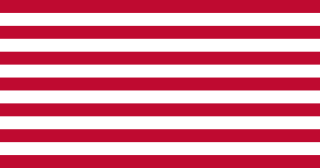Several ships of the United States Navy have been named USS Hancock or USS John Hancock, in honor of patriot, Founding Father, and statesman John Hancock.
Enterprise may refer to:
Fifteen ships of the Royal Navy have been named HMS Enterprise while another was planned:
USS Washington may refer to:

The second USS Boston was a 24-gun frigate, launched 3 June 1776 by Stephen and Ralph Cross, Newburyport, Massachusetts, and completed the following year. In American service she captured a number of British vessels. The British captured Boston at the fall of Charleston, South Carolina, renamed her HMS Charlestown, and took her into service. She was engaged in one major fight with two French frigates, which she survived and which saved the convoy she was protecting. The British sold Charlestown in 1783, immediately after the end of the war.
USS Franklin may refer to:

The Continental Navy was the navy of the United States during the American Revolutionary War and was founded October 13, 1775. The fleet cumulatively became relatively substantial through the efforts of the Continental Navy's patron John Adams and vigorous Congressional support in the face of stiff opposition, when considering the limitations imposed upon the Patriot supply pool.
USS Delaware was a 24-gun sailing frigate of the United States Navy that had a short career in the American Revolutionary War as the British Royal Navy captured her in 1777. The Royal Navy took her in as an "armed ship", and later classed her a sixth rate. The Royal Navy sold her in 1783. British owners named her United States and then French interests purchased her and named her Dauphin. She spent some years as a whaler and then in March 1795 she was converted at Charleston, South Carolina, to French privateer. Her subsequent fate is unclear.
Ten ships of the Royal Navy have carried the name HMS Spitfire, while an eleventh was planned but renamed before entering service. All are named after the euphemistic translation of Cacafuego, a Spanish treasure galleon captured by Sir Francis Drake.

USS Raleigh was one of thirteen ships that the Continental Congress authorized for the Continental Navy in 1775. Following her capture in 1778, she served in the Royal Navy as HMS Raleigh. The ship is featured on the flag and seal of New Hampshire.
The first USS Hancock was an armed schooner under the Continental Army during the American Revolutionary War. She was named for patriot and Continental Congress member John Hancock. Congress returned her to her owner in 1777.

HMS Drake was a Royal Navy 14-gun ship rigged sloop-of-war with a displacement of 275 tons burthen. Originally named the Royal Oak, she was built in New England in 1775 by John Wharton from Philadelphia. She first sailed between London and Stettin as a tobacco-ship. She was then sold in 1776 and renamed Resolution. Captained by Edward Hawker, the ship traded between London, Boston, and Cork. On 4 March 1777 the British navy purchased her at Plymouth for 3,000 pounds sterling. She completed fitting out as a warship on 24 May 1777. She became the ship-rigged sloop-of-war Drake with either 14, 18 or 20 guns. From July 17, 1777, she served in the American Revolutionary War. Her first mission was protecting the packet-boats between Harwich and Gorée
Six ships and a shore establishment of the Royal Navy have borne the name HMS Actaeon or HMS Acteon, after Actaeon, a figure in Greek mythology:
USS Warren may refer to the following ships of the United States Navy:
Nine ships of the Royal Navy have borne the name HMS Racehorse:
Seven ships of the Royal Navy have borne the name HMS Penguin. A penguin is a flightless aquatic bird.
USS Washington was a Continental Navy frigate laid down in 1776 but never completed.

John Barry was an Irish-American officer in the Continental Navy during the American Revolutionary War and later in the United States Navy. He has been credited as "The Father of the American Navy" and was appointed a captain in the Continental Navy on December 7, 1775. He was the first captain placed in command of a U.S. warship commissioned for service under the Continental flag.
Several vessels have been named Tartar: